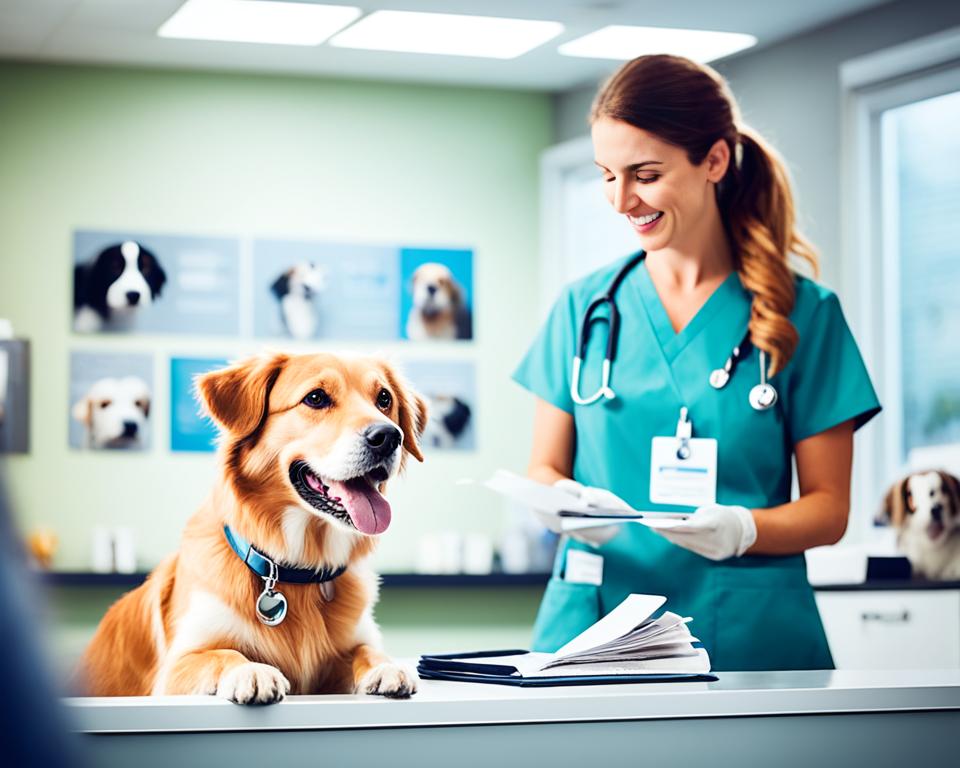As a pet owner, I know keeping our furry friends healthy and happy is key. It’s not just about feeding and walking them. It’s about making a caring space that helps them stay well.
Did you know 85% of pet owners think a balanced diet is key for their pet’s health? And 80% say regular vet visits are important. These facts show how vital good care is for pets. We’ll look at diet, exercise, and more to keep pets happy.
Let’s explore pet health and learn how to make our pets’ lives the best. These tips are great for new and experienced pet owners. They help build a strong bond with your pet and keep them healthy and happy.
The Importance of Proper Pet Nutrition
Pet nutrition is key to keeping our furry friends healthy and happy. As a pet owner, I’ve learned that a balanced diet is crucial. Let’s look at the basics of pet food and what pets need to eat.
Understanding Your Pet’s Nutritional Needs
Pets need different nutrients at different ages. Puppies and kittens under 3 months eat four times a day. Adult pets usually eat twice a day. Pet food bags often suggest too much food, so I start with less.
Choosing the Right Food for Different Life Stages
When picking pet food, I think about my pet’s age and health. Puppies, senior dogs, and pets with health issues may need special diets. I don’t give grain-free foods unless a vet says to, as they’re not needed for most pets and can be bad for them.
“Complete and balanced dog foods contain all necessary vitamins and minerals for pet health, eliminating the need for additional foods or supplements.”
The Role of Supplements in Pet Diets
Some pets might need dietary supplements, but not all. I talk to my vet before adding supplements to make sure they’re safe and needed. Omega-3 and omega-6 fatty acids help with healthy skin and reduce swelling.
- Proteins keep muscles strong and help with growth
- Fats give energy and help the brain work right
- Carbohydrates give quick energy and help with digestion
- Vitamins and minerals boost the immune system and cell health
Good pet nutrition means balance and meeting each pet’s needs. By choosing quality pet food and knowing what my pet needs, I can help my furry friend live a long, healthy life.
Exercise: Keeping Your Pet Active and Fit
I know how important exercise is for our pets. At Paws In Paradise Animal Hospital in Inlet Beach, Florida, we see how it helps pets every day. It keeps them at a healthy weight, builds muscle, and boosts heart health.
Exercise needs change with the pet’s species, breed, and age. Dogs need daily walks, play, running, or swimming. Cats like playing with toys. Birds might need flying activities. The main thing is to exercise your pet every day to keep them healthy.

- Sunrise and sunset walks when it’s cooler
- Indoor games with brain toys
- Water activities to stay cool in the summer
- Swimming – great for burning calories and cooling off
- Pet playdates for socializing in a cool place
Exercise is good for more than just physical health. It also lowers stress, anxiety, and bad behaviors. For puppies, it’s key for growing right. For older pets, it keeps them moving and active. By focusing on your pet’s exercise, you’re helping their overall health and happiness.
Weight Management for Optimal Pet Health
Pet obesity is a big problem in the U.S., with 56% of dogs and 60% of cats being overweight or obese. As a pet owner, I know how important weight management is for my furry friends’ health and long life.
Recognizing Obesity in Pets
It’s important to spot pet obesity early to stop health problems. I use body condition scoring to check my pet’s weight. For a 20-pound dog, one cookie is like a human eating a whole hamburger! This helps me control treats and keep a healthy diet.
Strategies for Healthy Weight Loss
Here are the steps I take for healthy weight loss for pets:
- Aim for a 3-5% weight reduction per month
- Choose high-quality weight-loss pet foods
- Limit treats to 10% of daily caloric intake
- Add low-calorie veggies like green beans to meals
- Gradually increase exercise, starting with 10% more walking time per week
Maintaining Ideal Body Condition
Keeping an ideal body condition is key for pet health. I work with my vet to make a weight management plan for my pet. By keeping my pet at a healthy weight, I can add over two years to their life. Even a little weight loss can lower the risk of serious health issues like diabetes, heart disease, and arthritis.
“A healthy pet is a happy pet. Proper weight management is one of the best gifts we can give our furry companions.”
Regular Veterinary Check-ups and Preventive Care

Regular vet visits are key for our pets’ health. They help prevent and catch health issues early. These visits are vital for keeping pets healthy.
Cats and dogs often hide when they’re in pain. By the time we notice, they might be hurting a lot. That’s why I book yearly check-ups for my pets. These include important tests and sometimes blood work or X-rays.
- Heart rate and lung sounds assessment
- Body temperature measurement
- Teeth and gum health evaluation
- Overall body condition check
Vets do more than just treat symptoms. They can spot early signs of diseases like diabetes and cancer. Catching these early can make treatment easier and cheaper. It also keeps me calm, knowing my pet is in good hands.
Regular vet visits are as crucial as feeding and playing with my pet. They’re a way to keep my pet healthy and happy for years. By focusing on preventive care, I help my pet live a long, joyful life.
Pet Health: Essential Preventative Medications
Keeping our furry friends healthy is a top priority. That’s why I’m excited to share some key info about preventative pet medications. These are crucial for maintaining your pet’s well-being and preventing serious health issues down the road.
Vaccinations for Disease Prevention
Vaccinations are the first line of defense against many dangerous diseases. For dogs and cats, core vaccines include rabies, parvo, and panleukopenia. Rabies is especially important as it can affect humans too. I make sure my pets get their shots on schedule to keep them safe.
Parasite Control: Fleas, Ticks, and Heartworms
Parasite prevention is another critical aspect of pet health. Fleas are the most common pest, but ticks and heartworms pose serious risks too. Did you know heartworm disease is 100% preventable with the right medication? I use year-round treatments to protect my pets from these nasty critters.
| Parasite | Risk | Prevention Method |
|---|---|---|
| Fleas | Skin irritation, anemia | Monthly topical or oral treatments |
| Ticks | Lyme disease, other infections | Tick collars, spot-on treatments |
| Heartworms | Potentially fatal heart disease | Monthly preventative medication |
Dental Care and Oral Health
Dental care is often overlooked but it’s super important. Regular teeth brushing and professional cleanings prevent plaque buildup and gum disease. I’ve learned that pets with clean mouths actually live longer! It’s amazing how much dental health impacts overall well-being.
Remember, your vet is your best resource for creating a tailored preventative care plan. They can recommend the right vaccinations, parasite prevention, and dental care routine for your unique pet. By staying on top of these essentials, we can help our pets live longer, healthier lives!
The Benefits of Spaying and Neutering
Pet spaying and neutering are key for controlling animal numbers and keeping pets healthy. They help our furry friends and communities a lot.
Spaying or neutering pets can stop some cancers and infections. Spayed females have less chance of getting uterine infections and breast tumors. Neutered males are less likely to get testicular cancer and some prostate problems.
These procedures also make pets behave better. Spayed females don’t go into heat, so they don’t yowl or pee where they shouldn’t. Neutered males don’t wander off, mark spots, or fight as much.
| Procedure | Benefits |
|---|---|
| Spaying | Prevents uterine infections, reduces breast tumor risk |
| Neutering | Eliminates testicular cancer risk, reduces prostate problems |
Pet spaying and neutering help control the pet population. Every year, millions of dogs and cats are put down because there are too many. By fixing our pets, we can lower this number a lot.
The best time to spay or neuter pets varies. Dogs can be neutered at eight weeks old, and cats can be at the same age. Always talk to your vet to find out when it’s best for your pet.
Remember, spaying and neutering are safe and common surgeries with few risks. They make our pets live longer, healthier lives. They also help us manage animal populations in a responsible way.
Grooming: More Than Just Aesthetics
Pet grooming is key for your furry friend’s health. Regular grooming keeps pets looking good and helps their health. Let’s look at the important parts of grooming every pet owner should know.
Brushing and Coat Maintenance
Brushing is key for coat care, especially for pets with long hair. It stops painful matting and tangling. I brush dogs with long or thick fur every 6-8 weeks for a healthy coat. Cats need less brushing, but long-haired ones might need more to avoid furballs.
Nail Trimming and Paw Care
Nail trimming is often missed but very important for your pet’s comfort. Long nails can cause pain, bone problems, and bad posture. I trim my pet’s nails often as part of our grooming routine. This simple step greatly improves their well-being.
Bathing and Skin Health
Regular baths keep skin healthy. Pets groomed often have fewer skin issues. During baths, I check for any unusual lumps or bumps that might need a vet.
Grooming is more than making pets look good. It reduces stress, strengthens the bond with your pet, and keeps your home clean. Adding grooming to your pet’s routine means you’re caring for their health and happiness.
Mental Stimulation and Behavioral Training
Pet mental health is as important as their physical health. Keeping pets mentally active stops boredom and stops bad behavior. Let’s look at ways to keep your pet’s mind sharp and happy.

Behavioral training is key for pet stimulation. Spending 5-15 minutes a day on training helps your dog’s mind and strengthens your bond. It boosts their thinking skills, confidence, and how well they listen.
Hide-and-seek is a great way to keep your pet’s mind sharp. It makes them think and use their nose. It’s fun for both of you and uses their natural instincts.
“You’ve got to feed the body and feed the mind.” – Dr. Marty Becker, Veterinarian
Interactive toys and puzzles are great for pet mental health. They keep pets busy and happy, releasing happy chemicals in their brains. I change my pet’s toys every week to keep them excited and avoid boredom.
A happy pet is a mentally stimulated pet. Adding these activities to your daily routine will make a big difference in your pet’s behavior and health.
Creating a Safe Home Environment for Pets
Pet safety is very important for all pet owners. Making our homes safe for pets is key. Let’s look at how to make our homes safe for our pets.
Pet-Proofing Your Living Spaces
Pet-proofing stops accidents and keeps pets safe. Securing cabinets and drawers with childproof locks helps a lot. Taking steps ahead can greatly lower the risk of pet accidents at home.
- Secure loose wires and cords
- Remove toxic plants from reach
- Store cleaning supplies in locked cabinets
- Use pet-proof trash bins to prevent rummaging
Identifying and Removing Household Hazards
It’s key to spot and remove home hazards for pets. I watch for small items that could choke pets and keep all medicines locked up. Safe chew toys made from non-toxic materials help avoid dental injuries and choking.
Safe Outdoor Spaces for Pets
Outdoor spaces must be safe too. I keep my yard free of toxic plants and make sure my fence is secure. Safe outdoor play helps pets stay healthy and avoid obesity.
| Safety Measure | Benefit |
|---|---|
| Pet-proof trash bins | Reduces potential hazards |
| Vertical spaces for cats | Improves mental well-being |
| Comfortable resting areas | Reduces stress and anxiety |
| Regular veterinary care | Enables early disease detection |
By using these safety steps, I’ve made a safe place for my pets. A safe home means happy, healthy pets!
The Power of Affection: Bonding with Your Pet
I’ve seen how pet bonding can change lives. Losing my beloved pet in 2021 showed me the deep bond between humans and animals. It’s more than just being together; it’s a strong connection that helps us feel better.
The American Veterinary Medical Association says being with pets can lower anxiety and blood pressure. It can even cut the risk of heart disease. Just petting your dog or cat can have big effects. These moments release stress-busting endorphins, making us and our pets happier and healthier.
Studies show the good things about pet bonding. The Human-Animal Bond Research Institute found that older people with pets feel less sad and worried. They move more and keep a healthy weight. Having a strong bond with animals is good for us and our pets. So, let’s enjoy those cuddles, playtimes, and quiet moments with our pets. They’re not just pets; they’re family members who make our lives better in many ways.

